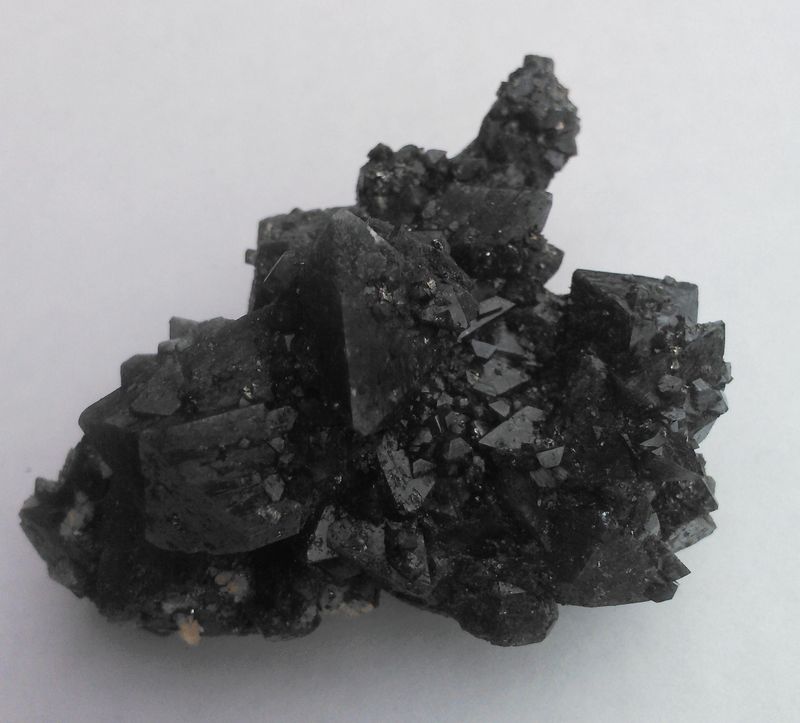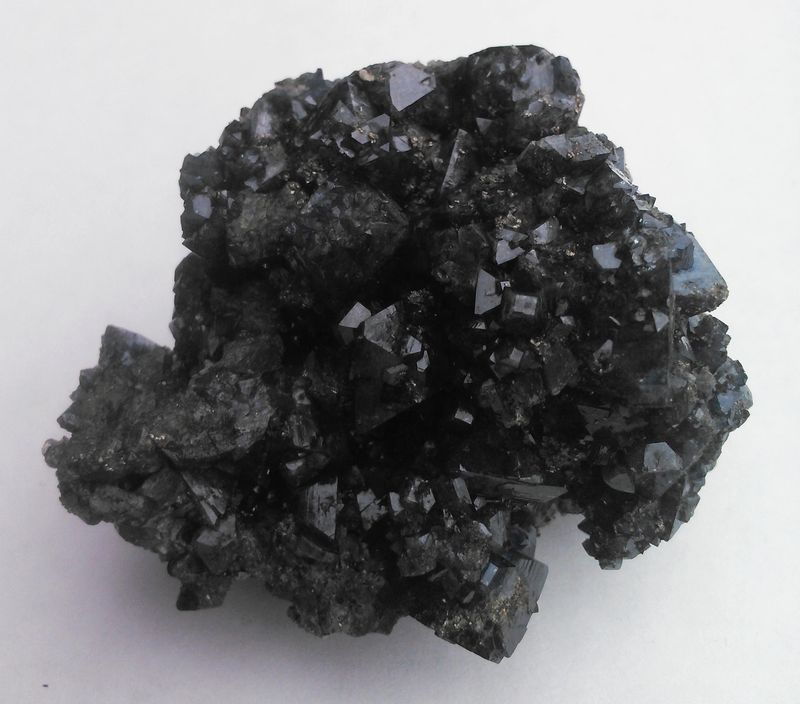| View previous topic :: View next topic |
| Author |
Message |
Peter Megaw
Site Admin

Joined: 13 Jan 2007
Posts: 973
Location: Tucson, Arizona



|
 Posted: Feb 07, 2014 02:19 Post subject: Scorodite from Ojuela Mine, Mapimí, Durango... Sulfur Isotope results Posted: Feb 07, 2014 02:19 Post subject: Scorodite from Ojuela Mine, Mapimí, Durango... Sulfur Isotope results |
|
|
Sometime shortly before the 2013 Denver Show a large lot of specimens of scorodite on pyrite specimens appeared...purportedly from the Ojuela Mine, Mapimi, Durango Mexico. The specimens bore an uncanny resemblance to material from China that hit the market in 2011...with nearly identical habit, color and matrix...down to the presence of tiny yellow segnitite (?) and sharp limpid quartz crystals in the matrix. The similarities called their authenticity into doubt and led to the withdrawal of the material from sale by several of the dealers holding the material. The questions were amplified by the fact that over the last few years materials demonstrably from non-Mexican localities (cf Spanish fluorite sold as coming from Naica) have been misrepresented in the Mexican end of the market, so the possibility that such visually similar material could also be misrepresented was difficult to dismiss.
Careful visual examination of many tens of samples in the stock of El Paso-based dealers Alfonso and Cristina Arriaga (Crystals from Heaven) and others led to no conclusive answers...in fact I personally thought that if "it walks like a duck, and talks like a duck...". However, the amount of material and the collecting stories associated with the material left significant room for doubt, so I suggested to the Arriagas that sulfur isotope analyses of the associated pyrite might help to settle the question. If the pyrites gave similar results it would strongly suggest a common origin, but if different that at the very least they did not come from the same mine/find as the well-known Chinese material.
They agreed, so I generated 2 samples of pyrite taken from their purported Ojuela specimens and 2 samples of pyrite from Chinese specimens provided by Dr. Marcus Origlieri, one of the earliest sources for the Chinese material. Pyrite was carefully extracted from each under a binocular microscope (only 0.3 mg is needed for analysis so generating clean separates is straightforward). The samples were submitted to Dr. Christopher Eastoe of the University of Arizona stable isotope laboratory for sulfur isotopic analysis. The samples were run Monday of this week and the results received today are:
Location Sample # Sulfur Isotope ratio (del 34S in permil)
Pyrite China #1 13772 -1.1
Pyrite China #2 13773 -1.0
Pyrite Ojuela? #1 13774 8.2
Pyrite Ojuela? #2 13775 8.3
Both samples from each locality gave very similar results and the 9 permil difference between them is significant. Many large ore deposits show very little sulfur isotope variation throughout (Naica, <3>2 km) not over the scale of what we think of as a single pocket zone.
This suggests that it is highly unlikely that pyrite associated with such similar appearing materials from the same mine/ore deposit would have such dramatically different sulfur isotope values, which strongly indicates that the purported Ojuela material is from a different source from the well-known Chinese material.
Although this does not guarantee that the "Ojuela" material is in fact from Ojuela it lends significant credence to the collecting stories coming from Ojuela and that we are seeing a remarkable example of "mineralogical convergent evolution" perhaps reflecting very similar conditions of growth in two widely separated localities.
It is worth noting that high-precision sulfur analyses are quite inexpensive (<$20) and appear to present an objective means for eliminating significant doubts concerning the origin of sulfur-bearing species. Other stable isotopes (cf Oxygen, Hydrogen, and Carbon) are equally inexpensive to analyze and separately or in combination could also be valuable verification tools.
I hope to obtain additional samples of pyrite from Ojuela for analysis to tighten this argument, but feel that the data and provenance histories strongly indicate that we can accept that Ojuela is indeed the source.
| Description: |
Scorodite
Mina Ojuela, Mapimi, Durango, Mexico
5 x 4 cm. Largest crystal 1 cm
Crystals from Heaven specimen, Peter Megaw image |
|
| Viewed: |
22409 Time(s) |

|
| Description: |
Scorodite
Mina Ojuela, Mapimi, Durango, Mexico
4 x 4 cm
Crystals from Heaven specimen, Peter Megaw image |
|
| Viewed: |
22412 Time(s) |

|
_________________
Siempre Adelante! |
|
| Back to top |
|
 |
Jean Sendero

Joined: 20 Dec 2009
Posts: 270
Location: Hudson Heights, Quebec



|
 Posted: Feb 07, 2014 07:59 Post subject: Re: Scorodite from Ojuela Mine, Mapimí, Durango... Sulfur Isotope results Posted: Feb 07, 2014 07:59 Post subject: Re: Scorodite from Ojuela Mine, Mapimí, Durango... Sulfur Isotope results |
|
|
Thank you Peter and Marcus,
This is a surprise and I appreciate your perseverance at seeking the truth on these. I will bite my tongue now and accept the fact that they are from Ojuela.
Jean
|
|
| Back to top |
|
 |
lluis
Joined: 17 Nov 2006
Posts: 719


|
 Posted: Feb 07, 2014 09:33 Post subject: Re: Scorodite from Ojuela Mine, Mapimí, Durango... Sulfur Isotope results Posted: Feb 07, 2014 09:33 Post subject: Re: Scorodite from Ojuela Mine, Mapimí, Durango... Sulfur Isotope results |
|
|
Many thanks, Peter!
Really interesting
With best wishes
Lluís
|
|
| Back to top |
|
 |
chris
Site Admin

Joined: 12 Jul 2007
Posts: 538
Location: Grenoble



|
 Posted: Feb 07, 2014 10:52 Post subject: Re: Scorodite from Ojuela Mine, Mapimí, Durango... Sulfur Isotope results Posted: Feb 07, 2014 10:52 Post subject: Re: Scorodite from Ojuela Mine, Mapimí, Durango... Sulfur Isotope results |
|
|
Hi Peter,
Thanks for the information. Have fun in Tucson.
Christophe
|
|
| Back to top |
|
 |
Gold Rock Doc
Joined: 28 May 2012
Posts: 6
Location: WA


|
 Posted: Feb 08, 2014 02:49 Post subject: Re: Scorodite from Ojuela Mine, Mapimí, Durango... Sulfur Isotope results Posted: Feb 08, 2014 02:49 Post subject: Re: Scorodite from Ojuela Mine, Mapimí, Durango... Sulfur Isotope results |
|
|
Yes, it would appear that these results do support a separate origin for the two specimens. But your assertion that sulfur isotopes do not vary over pocket-size distances is quite incorrect. Work at Creede Colorado has shown that variations of over 100 per mil can occur on a dimension-scale of millimetres or less.
Environment and process of formation is very important. The difference between the fluid sulfur (source) composition and sulfide mineral is often quite large (>20 per mil). If the source reservoir is small (or fluid migration is slow), then the fluid composition will evolve, fractionate, relatively quickly and early material will have a much different signature that later material by a relatively large value.
Your results are suggestive, but as you point out more work seems warranted.
_________________
Keep on trucken' |
|
| Back to top |
|
 |
Peter Megaw
Site Admin

Joined: 13 Jan 2007
Posts: 973
Location: Tucson, Arizona



|
 Posted: Feb 08, 2014 11:16 Post subject: Re: Scorodite from Ojuela Mine, Mapimí, Durango... Sulfur Isotope results Posted: Feb 08, 2014 11:16 Post subject: Re: Scorodite from Ojuela Mine, Mapimí, Durango... Sulfur Isotope results |
|
|
You are right that significant fine-scale sulfide sulfur isotope variations exist, in fact some SHRIMP work reveals variations between individual growth layers in some sulfide species. This is why I took two samples from each specimen from quite different parts of the matrix. The results for each location match closely, suggesting that fine-scale variation either is not at play, or is averaged out consistently in each.
Systematic sulfur isotope sampling in Ojuela-like CRDs (cf Santa Eulalia and Naica) shows either very little variation (Naica) or very consistent large-scale (100s-1000m) zoning (Santa Eulalia), suggesting that the kinds of isolation effects you note for Creede may not be much of a factor here.
More work is definitely needed (when is it not?) and potentially generation of isotopic "thumbprints" for well-located known natural materials can allow comparison with unknown, or questionable specimens. The dollar amounts at play in today's market are significant and very low cost stable isotope analyses may be very useful for solving several specimen-related conundrums, such as this scorodite question... and perhaps even thornier questions such as the "native" silver specimens purportedly from Germany that many believe are lab-grown.
_________________
Siempre Adelante! |
|
| Back to top |
|
 |
|




